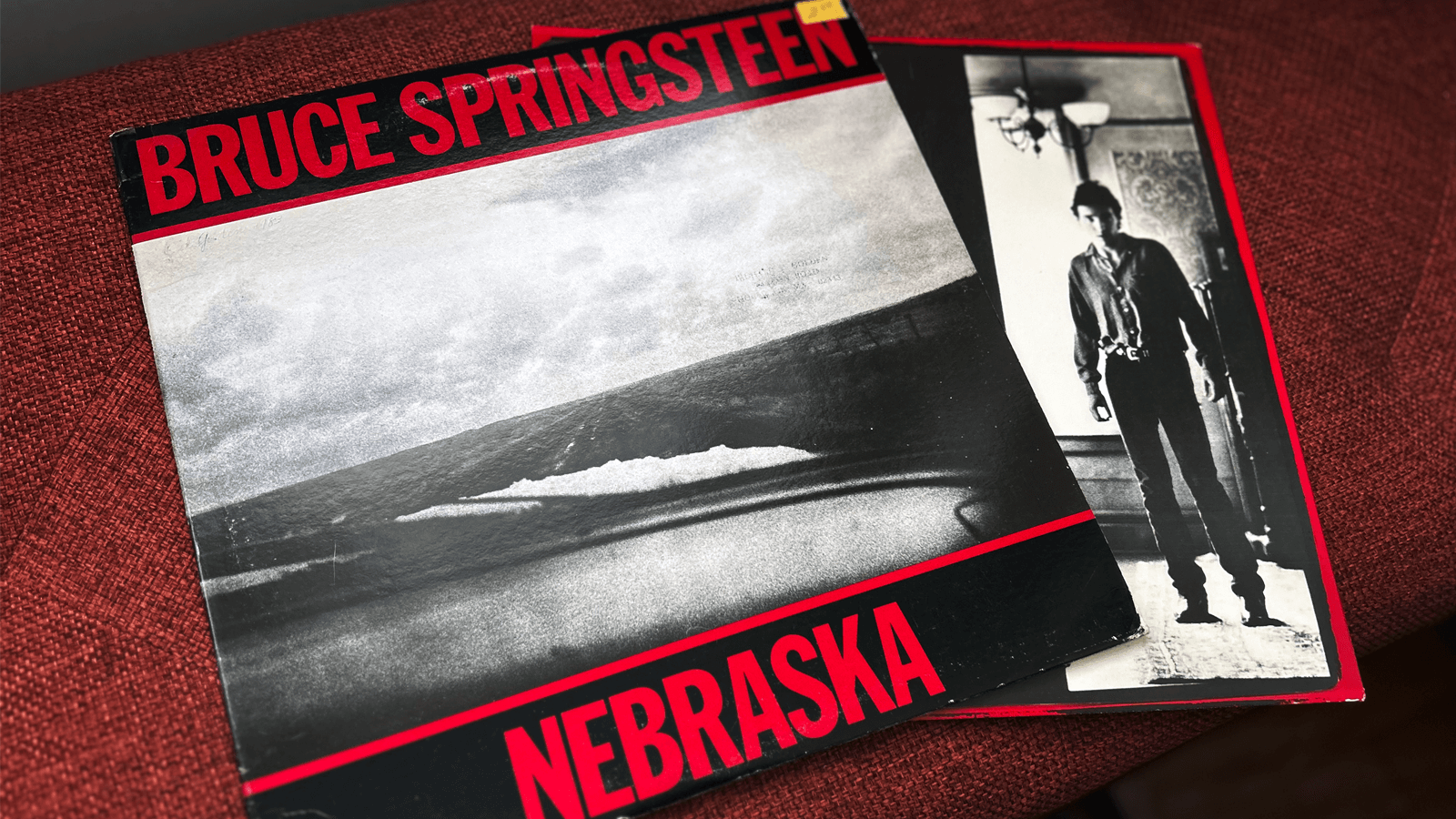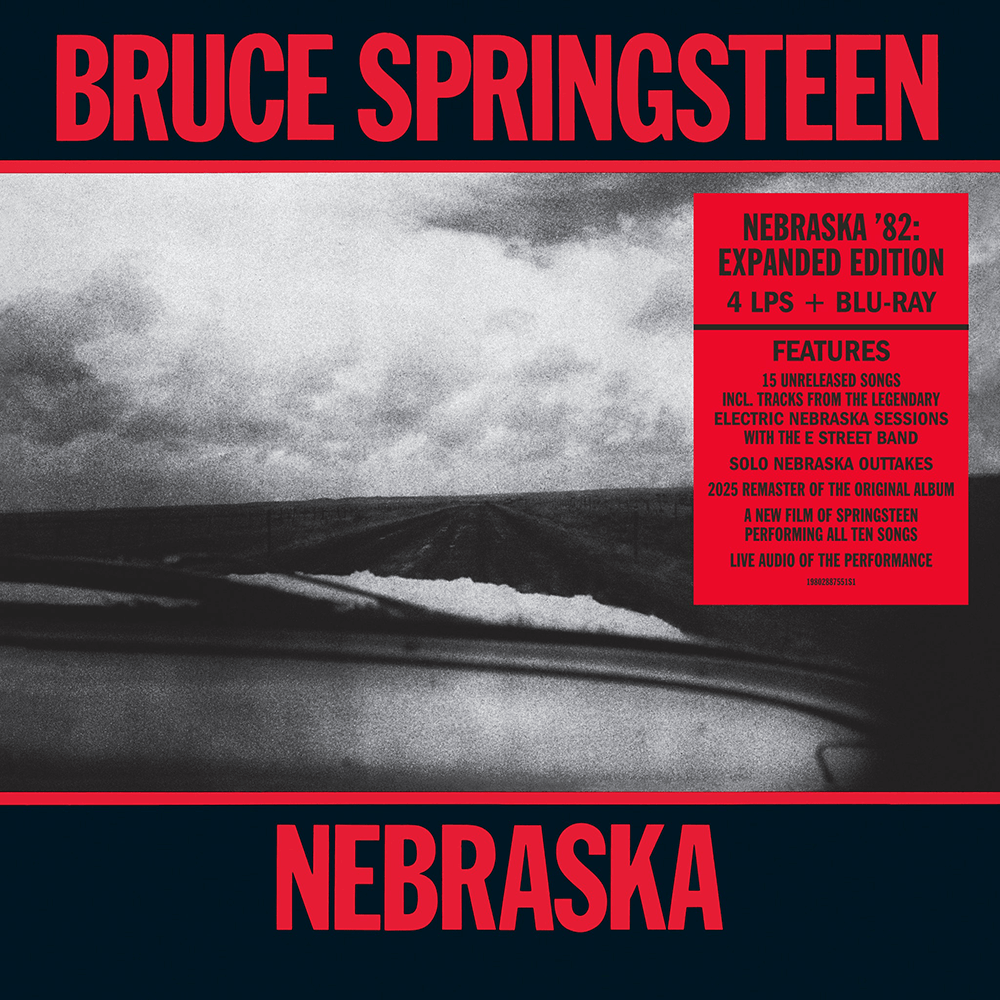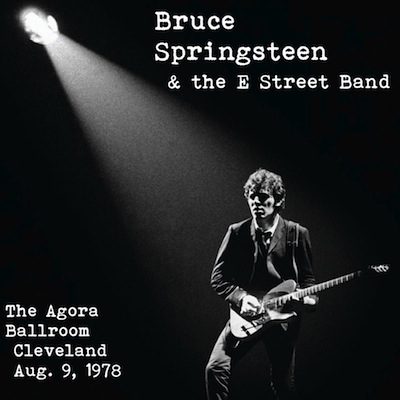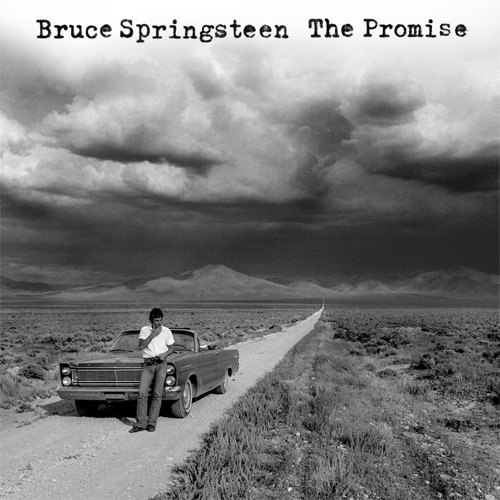There’s a meanness, and there’s a reason to believe: scattered thoughts on Bruce Springsteen and Nebraska
By NICK TAVARES
STATIC and FEEDBACK Editor

It’s been a long few weeks, hasn’t it? Maybe you’ve felt it. Maybe it’s just me.
On a long train ride home recently, it was dark and I was sitting in the quiet car of the Northeast Regional with my headphones on, listening to Bruce Springsteen’s Nebraska and just kind of absent-mindedly staring out while the lights passed in a blur. The other day, it was daylight and I could see the ocean while we rode down along the coast. On this day, I’m on the other side of the tracks, watching warehouses and gas stations run together while the hours tick down until the train pulls into Boston.
So, with things feeling bogged down, and mildly exhausted in this moment, Nebraska hit all the right notes. And it’s served this purpose for years — originally released in September 1982 and then rereleased this month as an expanded box set.
My copy of Nebraska is one of the records I’ve had the longest; I found it at the Raynham flea market in the early 2000s, and it still has its handwritten $2.50 price tag in the top corner. Looking more closely at it, there’s an imprinted ballpoint pen signature of “Rick Golden 1983” in the top left corner, and a faded stamp above the horizon for an address in Massachusetts on the right. So Rick, if you’re out there, please know your record is in good hands and still sounds great.
Anyway. Even before I got really into Springsteen, this record spoke to me and hit someplace deeper. I’ve always been a fan of spare, acoustic things, and few records are as spare and dark as this one. But it took a few years, after the brilliance of albums like Darkness on the Edge of Town finally clicked, where I was able to go back and truly appreciate what was happening here. This was an artist with a singular determination and a willingness to explore these different points of view, coming from places of hope, grief, awkwardness, frustration, joy, despair. After giving voice to all these characteristics and emotions, he looked further inward and began to wonder what else there might be.
He stripped back the excess, removing the audience and his band and management, and explored the darker corners of this life and the folks that inhabit it. And he summed it up in the final line of his new album’s title track:
“Sir, I guess there’s just a meanness in this world.”
![]()
The space this album occupies in his cannon — and at that particular arc of his career — has always been fascinating. Coming off a three album run of Born to Run, Darkness on the Edge of Town and The River, playing sold-out shows in arenas and landing song after song on radio playlists, he was due for a grand reckoning. Not to oversell it, but coming into this period, he was truly on fire. For a great example of this, check out his monster show at Nassau Coliseum on New Year’s Eve. It’s nearly four hours of breakneck energy, a near-constant surge that only occasionally calms down on the slower numbers before the band rings in 1981. The moment was coming where he would become the biggest force in rock music, bar none.
And he got there, of course. Born in the U.S.A. was an absolute monster, with seven out of 10 songs released as singles, 30 million copies sold worldwide, placing him and the E Street Band in stadiums around the world for the better part of two years. He was on magazine covers, on MTV, in Ronald Reagan’s mouth. He was everywhere.
But in a fast-paced, fickle musical landscape, this detour to Nebraska is even more fascinating. There was no tour for the album, no singles released domestically. There are mistakes on it, with his overdubs sometimes not syncing up perfectly, because of course, they didn’t have to be perfect. They were demos, intended to take to the band to prep for the next record and tour.
Listening to Electric Nebraska, finally surfacing after more than 40 years, they made a solid go of it, too. “Nebraska” and “Mansion on the Hill,” for the most part, maintain their spooky atmosphere. The songs are obviously not as raw, and they’re augmented by the bones of the E Street Band, but the departure from his prior records is already present.
But the tortured soul of the original album is missing on songs like “Atlantic City” and “Johnny 99,” which take on the spirit that they’ve had in his live shows for all these years. And they sound great, all rousing and restless, but it’s illustrative that he made the right choice in releasing Nebraska as it appeared. “Johnny 99,” in particular, would’ve been great in a roadhouse, with drinks flying and the crowd worked up in a frenzy, if it weren’t for the story and the message of the song about a man at his wit’s end staring down a life in prison getting completely lost in the process.
That said, I’ll take the versions of “Born in the U.S.A.” and “Downbound Train” here over their later counterparts any day. If this recording of “Born in the U.S.A.” had been carried over to its titular album, it would not have been as big a hit as the 1984 recording, obviously. But the meaning and the message is much less likely to have been lost, buried under the bombastic arrangement of the final reading.
Listening to the outtakes on the set’s first LP, it’s also clear that he made the right call in the 10 songs he chose to release. Again, the acoustic “Born in the U.S.A.” would have fit right in along the other character studies, but a song like “Losin’ Kind,” the other side of “Highway Patrolman,” would’ve felt redundant within the running order of the album. But the song is strong on its own, as a number of these are here, like the first takes of “Pink Cadillac” and “Working on the Highway.” And it’s all a testament to how productive and in the zone he was at this time, where the stark tales on “Gun in Every Home” and “Child Bride" were left aside in an effort to keep Nebraska a concise, powerful record.
Surprisingly for me, the highlight of all the new material might be on the live renditions recorded at the Count Basie Theatre in Red Bank, N.J., earlier this year. His voice is a bit more weathered than it was in 1982, obviously, and some of the inflections in the songs have evolved through the years (particularly “Atlantic City”), but the haunting atmosphere of the original returns immediately. Somehow, the songs regain that creepy magic of his 1982 home recordings 43 years later, which he couldn’t capture in the studio at the time. Maybe it’s the years and the miles. Maybe he better understands the characters he created in his older age. Maybe it’s all just another magic trick, getting people like me to buy into the warmth and intimacy of the moment. Whatever it is, it works. I’m buying in.
![]()
“Maybe everything that dies, someday comes back.”
I think about that line from “Atlantic City” quite a bit. Its narrator is well aware that he’s on his last legs and about to do something incredibly desperate and risky in an effort to come out the other side in a better place. But he knows it’s the end of the line. He’s thought about it, about every step and trickle and moment that pile atop each other over the years and lead him to this moment where it’s likely the end.
But there’s the faintest glimmer of hope there. We’ve reached the end. There’s no coming back in this case, but maybe we all get another turn on the carousel, another chance to get it right. But maybe everything that dies, some day comes back.
It’s an album full of regrettable decisions made under brutal circumstances by different people. The singer in “State Trooper” is ready to do whatever it takes to get out to the other side, and he will take anyone down who stands in his way. The “Highway Patrolman” has made peace with his choices and his loyalties, ready to suffer whatever consequences occur as a result. “Johnny 99” hopes you understand how he got here, but he’s ready to meet his fate. Charles Starkweather doesn’t care what you think. Himself, Springsteen’s hidden id is still searching through the pieces of his life for understanding, in “My Father’s House,” in “Used Cars,” in “Mansion on the Hill,” in “Reason to Believe.”
The album has lasted so long because, while most people aren’t criminals and murderers, they do get desperate, and alone, and isolated, and just tired. The record lives for those moments, to give voice to those emotions and illustrate some of the ways they could play out.
![]()
As I made my way home late from a work trip the other night, I still had Nebraska running on a loop through my headphones. I made my 15-minute walk from the train back to the house, queued up just as the closing combo of “My Father’s House” and “Reason to Believe” were due, before the album wrapped around and Springsteen’s harmonica took me those last few steps to the door.
Has there ever been a better album for listening to alone, walking home on an October night? Traffic was nonexistent. The leaves on the ground were still wet and glistening a bit in the lights. There were only a couple of other people walking on the street. It was just Bruce and those characters, all painfully real and all reminders of how low we can get and how much lower it could really go.
Still, they keep going. They get up, they move about their lives, they live with regret and anger and shame and hope. They all keep searching, in vain or not. Through all the long nights and weeks and months and years, they find some reason to believe.
Oct. 25, 2025
Email Nick Tavares at nick@staticandfeedback.com











